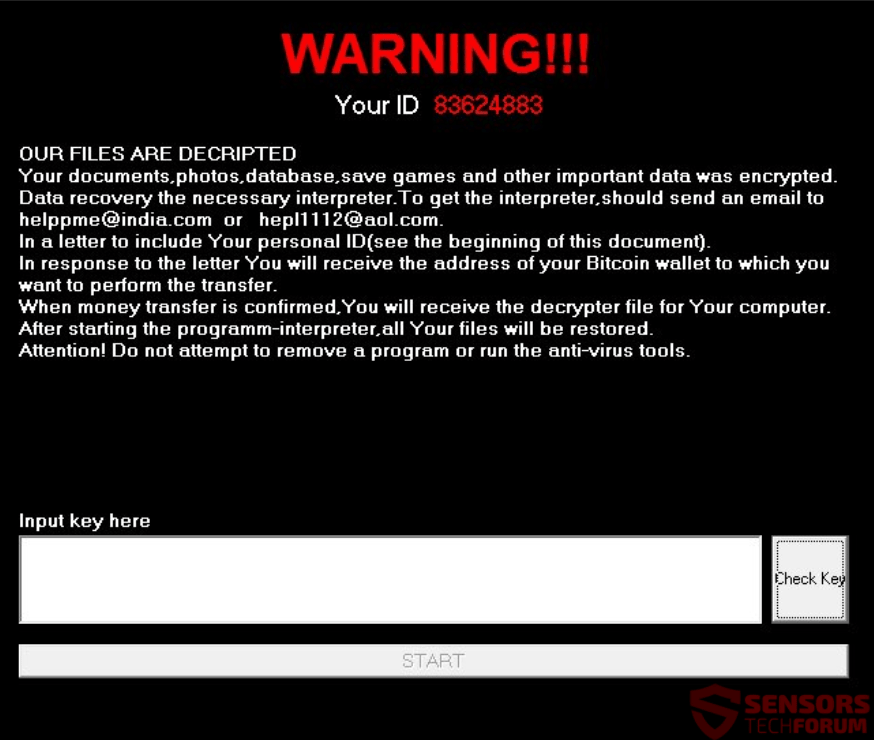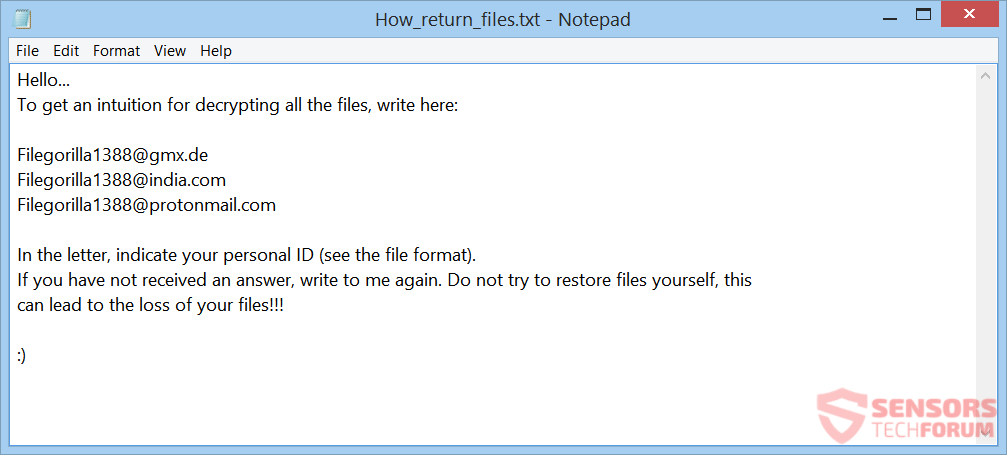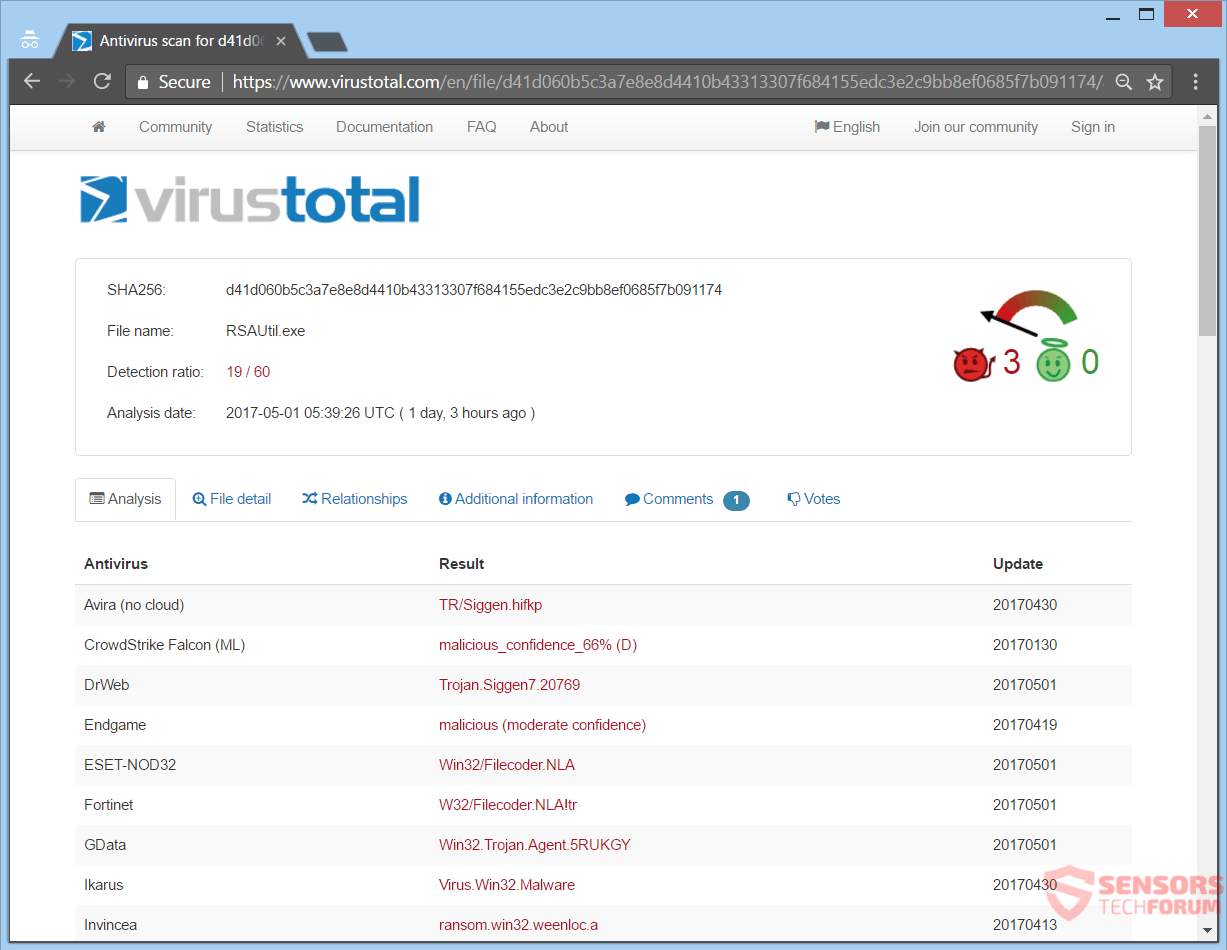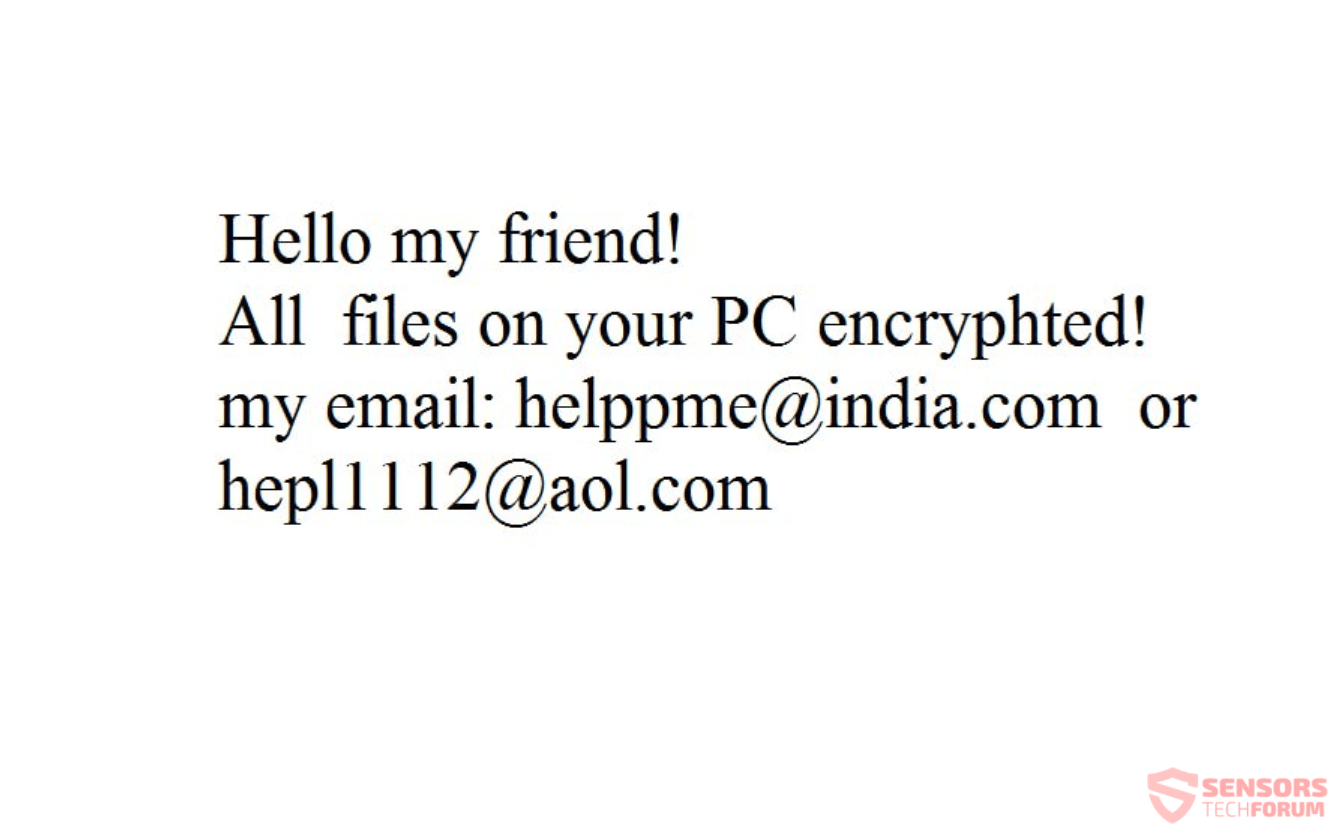This article will aid you in removing the RSAUtil ransomware fully. Follow the ransomware removal instructions given at the end of the article.
The RSAUtil ransomware has been discovered by the malware researcher known by the handle @PolarToffee on Twitter. It will encrypt your files, while adding the .helppme@india.com.ID extension to them afterward. When a computer system gets infected, the RSAUtil virus will show a ransom note and a window with instructions about paying the ransom.

Threat Summary
| Name | RSAUtil |
| Type | Ransomware, Cryptovirus |
| Short Description | The ransomware virus will encrypt your files and show a message screen with ransomware instructions for payment, including a ransom note. |
| Symptoms | The ransomware will encrypt your files while placing the .helppme@india.com.ID extension to them, where the ID is specific for each user. |
| Distribution Method | Spam Emails, Email Attachments |
| Detection Tool |
See If Your System Has Been Affected by malware
Download
Malware Removal Tool
|
User Experience | Join Our Forum to Discuss RSAUtil. |
| Data Recovery Tool | Windows Data Recovery by Stellar Phoenix Notice! This product scans your drive sectors to recover lost files and it may not recover 100% of the encrypted files, but only few of them, depending on the situation and whether or not you have reformatted your drive. |

RSAUtil Virus – Update May 2018
The month of May brings a new update to the RSAUtil Virus. Malware analysts have seen samples with a modified ransom note and new contact e-mail addresses. The ransom note is inside a file called “How_return_files.txt” and can be viewed from the below screenshot:
The ransom note states the following:
Hi friend… :)
For instructions on how to recovery the files, write to me:
Tizer78224@gmx.de
Tizer78224@india.com
Tizer77234@protonmail.com
In the letter, indicate your personal ID (see the file format).
If you have not received an answer, write to me again.
The following e-mail addresses are used as a way of contacting the cybercriminals:
- Tizer78224@gmx.de
- Tizer78224@india.com
- Tizer77234@protonmail.com
During the past few months more samples have been found, which had minor changes to the malware. The article will get updated if something new surrounding the malware threat is discovered.

RSAUtil Virus – Update December 2017
Malware researchers have discovered changes made to the RSAUtil Virus, this December, with a new ransom note and new extensions. The ransom note is inside a file called “How_return_files.txt” and can be viewed down here:
That ransom note states the following:
Hello…
To get an intuition for decrypting all the files, write here:Filegorilla1388@gmx.de
Filegorilla1388@india.com
Filegorilla1388@protonmail.comIn the letter, indicate your personal ID (see the file format).
If you have not received an answer, write to me again. Do not try to restore files yourself, this
can lead to the loss of your files!!!:)
As to the new extensions that encrypted files receive – they are “.ID
- vendetta553@gmx.de
- vendetta553@india.com
- vendetta553@protonmail.com
It seems that there can be more changes as well, but for the time being this is the pattern that the ransomware’s developers use for changing their malware. If there are more news regarding the matter, the article will get duly updated.

RSAUtil Virus – Infection Spread
RSAUtil ransomware could spread its infection in different ways. The payload file which initiates the malicious script for this ransomware, that in turn infects your computer machine, has been seen around the Internet. Samples of this ransomware have been found by a few different malware researchers. You can see the detections of security vendors for one of those samples which is called “RSAUtil.exe” by checking the screenshot of the VirusTotal platform below:
The RSAUtil ransomware could also spread its payload file on social media websites and file-sharing networks. Freeware applications which are found on the Web could be presented as useful but at the same time could be hiding the malicious script for this cryptovirus. Don’t be opening files right when you have downloaded them, especially if they come from sources such as suspicious links or emails. Instead, you should scan them beforehand with a security tool, while also checking the sizes and signatures of those files for anything that seems unusual. You should read the ransomware prevention tips located on our forum.

RSAUtil Virus – Technical Overview
RSAUtil is how a new cryptovirus is dubbed, which is written on the Delphi programming language. The main reason for that name may be that one of its malware samples bears the same name and that it probably uses an “RSA Utility” for encryption. After your files get encrypted, they will all receive the .helppme@india.com.ID extension. One of the first samples of the virus was discovered by the malware researcher known as @PolarToffee on Twitter.
The RSAUtil ransomware could make entries in the Windows Registry aiming to achieve a higher level of persistence. Those registry entries are typically designed in a way that will start the virus automatically with each launch of the Windows Operating System. An example of such an entry is the following:
→“HKEY_LOCAL_MACHINE\Software\Microsoft\Windows\CurrentVersion\Run”
When the encryption process is finished a ransom message will display within a window and another smaller note as a picture. The window is with a black background and provides instructions on what steps to make to pay the ransom. You can see that message in the screenshot provided below:
The ransom message loads in a window and reads the following:
WARNING!!!
Your ID 83624883
OUR FILES ARE DECRIPTED
Your documents, photos, database, save games and other important data was encrypted.
Data recovery the necessary interpreter. To get the interpreter, should send an email to helppme@india.com or hepl1112@aol.com.
In a letter to include Your personal ID (see the beginning of this document).
In response to the letter You will receive the address of your Bitcoin wallet to which you want to perform the transfer.
When money transfer is confirmed, You will receive the decrypter file for Your computer.
After starting the programm-interpreter, all Your files will be restored.
Attention! Do not attempt to remove a program or run the anti-virus tools.
Another message accompanies the ransom message window, and that is a small note:
That note reads:
Hello my friend!
All files on your PC encryphted!
my email: helppme@india.com or
hepll 112@aol.com
As clearly seen from the ransom message above and also written in a file called “How_return_files.txt” (wich is dropped inside every folder with encrypted files), the developer of the RSAUtil virus wants you to send a message to one of the following two email addresses:
- helppme@india.com
- hepll112@aol.com
However, if you get your personal computer infected with the malware, you should NOT under any circumstances pay anything to the cybercriminal behind it. Nobody can give you a guarantee that you will get your files decrypted upon paying.

RSAUtil Virus – Encryption Process
RSAUtil ransomware will most probably search and encrypt files, which have the following extensions:
→.doc, .docx, .pdf, .db, .jpg, .png, .ppt, .pptx, .txt, .xls, .xlsx
The extensions mentioned above are for the most commonly used file types under the Windows Operating System, but that list is most probably bigger and could get updated. The RSA algorithm is believed to be applied here in the encryption process. The extension .helppme@india.com.ID is put to all encrypted files, where the ID number is scpecific for each user. Here the ID is 83624883, so the full extension appended to an encrypted file is .helppme@india.com.ID83624883.
In case the ransomware runs on a Virtual Machine, it won’t encrypt files, but only display the following error message:
The RSAUtil cryptovirus could be set to erase the Shadow Volume Copies from the Windows Operating System by initiating the following command:
→vssadmin.exe delete shadows /all /Quiet
The execution of that command will make the encryption process more viable, since it eliminates one of the prominent ways for the restoration of your files.

Remove RSAUtil Virus and Restore .helppme@india.com.ID Files
If your computer got infected with the RSAUtil ransomware virus, you should have a bit of experience in removing malware. You should get rid of this ransomware as quickly as possible before it can have the chance to spread further and infect other computers. You should remove the ransomware and follow the step-by-step instructions guide provided below.
- Step 1
- Step 2
- Step 3
- Step 4
- Step 5
Step 1: Scan for RSAUtil with SpyHunter Anti-Malware Tool



Ransomware Automatic Removal - Video Guide
Step 2: Uninstall RSAUtil and related malware from Windows
Here is a method in few easy steps that should be able to uninstall most programs. No matter if you are using Windows 10, 8, 7, Vista or XP, those steps will get the job done. Dragging the program or its folder to the recycle bin can be a very bad decision. If you do that, bits and pieces of the program are left behind, and that can lead to unstable work of your PC, errors with the file type associations and other unpleasant activities. The proper way to get a program off your computer is to Uninstall it. To do that:


 Follow the instructions above and you will successfully delete most unwanted and malicious programs.
Follow the instructions above and you will successfully delete most unwanted and malicious programs.
Step 3: Clean any registries, created by RSAUtil on your computer.
The usually targeted registries of Windows machines are the following:
- HKEY_LOCAL_MACHINE\Software\Microsoft\Windows\CurrentVersion\Run
- HKEY_CURRENT_USER\Software\Microsoft\Windows\CurrentVersion\Run
- HKEY_LOCAL_MACHINE\Software\Microsoft\Windows\CurrentVersion\RunOnce
- HKEY_CURRENT_USER\Software\Microsoft\Windows\CurrentVersion\RunOnce
You can access them by opening the Windows registry editor and deleting any values, created by RSAUtil there. This can happen by following the steps underneath:


 Tip: To find a virus-created value, you can right-click on it and click "Modify" to see which file it is set to run. If this is the virus file location, remove the value.
Tip: To find a virus-created value, you can right-click on it and click "Modify" to see which file it is set to run. If this is the virus file location, remove the value.
Before starting "Step 4", please boot back into Normal mode, in case you are currently in Safe Mode.
This will enable you to install and use SpyHunter 5 successfully.
Step 4: Boot Your PC In Safe Mode to isolate and remove RSAUtil





Step 5: Try to Restore Files Encrypted by RSAUtil.
Method 1: Use STOP Decrypter by Emsisoft.
Not all variants of this ransomware can be decrypted for free, but we have added the decryptor used by researchers that is often updated with the variants which become eventually decrypted. You can try and decrypt your files using the instructions below, but if they do not work, then unfortunately your variant of the ransomware virus is not decryptable.
Follow the instructions below to use the Emsisoft decrypter and decrypt your files for free. You can download the Emsisoft decryption tool linked here and then follow the steps provided below:
1 Right-click on the decrypter and click on Run as Administrator as shown below:

2. Agree with the license terms:

3. Click on "Add Folder" and then add the folders where you want files decrypted as shown underneath:

4. Click on "Decrypt" and wait for your files to be decoded.

Note: Credit for the decryptor goes to Emsisoft researchers who have made the breakthrough with this virus.
Method 2: Use data recovery software
Ransomware infections and RSAUtil aim to encrypt your files using an encryption algorithm which may be very difficult to decrypt. This is why we have suggested a data recovery method that may help you go around direct decryption and try to restore your files. Bear in mind that this method may not be 100% effective but may also help you a little or a lot in different situations.
Simply click on the link and on the website menus on the top, choose Data Recovery - Data Recovery Wizard for Windows or Mac (depending on your OS), and then download and run the tool.
RSAUtil-FAQ
What is RSAUtil Ransomware?
RSAUtil is a ransomware infection - the malicious software that enters your computer silently and blocks either access to the computer itself or encrypt your files.
Many ransomware viruses use sophisticated encryption algorithms to make your files inaccessible. The goal of ransomware infections is to demand that you pay a ransom payment to get access to your files back.
What Does RSAUtil Ransomware Do?
Ransomware in general is a malicious software that is designed to block access to your computer or files until a ransom is paid.
Ransomware viruses can also damage your system, corrupt data and delete files, resulting in the permanent loss of important files.
How Does RSAUtil Infect?
Via several ways.RSAUtil Ransomware infects computers by being sent via phishing emails, containing virus attachment. This attachment is usually masked as an important document, like an invoice, bank document or even a plane ticket and it looks very convincing to users.
Another way you may become a victim of RSAUtil is if you download a fake installer, crack or patch from a low reputation website or if you click on a virus link. Many users report getting a ransomware infection by downloading torrents.
How to Open .RSAUtil files?
You can't without a decryptor. At this point, the .RSAUtil files are encrypted. You can only open them once they are decrypted using a specific decryption key for the particular algorithm.
What to Do If a Decryptor Does Not Work?
Do not panic, and backup the files. If a decryptor did not decrypt your .RSAUtil files successfully, then do not despair, because this virus is still new.
Can I Restore ".RSAUtil" Files?
Yes, sometimes files can be restored. We have suggested several file recovery methods that could work if you want to restore .RSAUtil files.
These methods are in no way 100% guaranteed that you will be able to get your files back. But if you have a backup, your chances of success are much greater.
How To Get Rid of RSAUtil Virus?
The safest way and the most efficient one for the removal of this ransomware infection is the use a professional anti-malware program.
It will scan for and locate RSAUtil ransomware and then remove it without causing any additional harm to your important .RSAUtil files.
Can I Report Ransomware to Authorities?
In case your computer got infected with a ransomware infection, you can report it to the local Police departments. It can help authorities worldwide track and determine the perpetrators behind the virus that has infected your computer.
Below, we have prepared a list with government websites, where you can file a report in case you are a victim of a cybercrime:
Cyber-security authorities, responsible for handling ransomware attack reports in different regions all over the world:
Germany - Offizielles Portal der deutschen Polizei
United States - IC3 Internet Crime Complaint Centre
United Kingdom - Action Fraud Police
France - Ministère de l'Intérieur
Italy - Polizia Di Stato
Spain - Policía Nacional
Netherlands - Politie
Poland - Policja
Portugal - Polícia Judiciária
Greece - Cyber Crime Unit (Hellenic Police)
India - Mumbai Police - CyberCrime Investigation Cell
Australia - Australian High Tech Crime Center
Reports may be responded to in different timeframes, depending on your local authorities.
Can You Stop Ransomware from Encrypting Your Files?
Yes, you can prevent ransomware. The best way to do this is to ensure your computer system is updated with the latest security patches, use a reputable anti-malware program and firewall, backup your important files frequently, and avoid clicking on malicious links or downloading unknown files.
Can RSAUtil Ransomware Steal Your Data?
Yes, in most cases ransomware will steal your information. It is a form of malware that steals data from a user's computer, encrypts it, and then demands a ransom in order to decrypt it.
In many cases, the malware authors or attackers will threaten to delete the data or publish it online unless the ransom is paid.
Can Ransomware Infect WiFi?
Yes, ransomware can infect WiFi networks, as malicious actors can use it to gain control of the network, steal confidential data, and lock out users. If a ransomware attack is successful, it could lead to a loss of service and/or data, and in some cases, financial losses.
Should I Pay Ransomware?
No, you should not pay ransomware extortionists. Paying them only encourages criminals and does not guarantee that the files or data will be restored. The better approach is to have a secure backup of important data and be vigilant about security in the first place.
What Happens If I Don't Pay Ransom?
If you don't pay the ransom, the hackers may still have access to your computer, data, or files and may continue to threaten to expose or delete them, or even use them to commit cybercrimes. In some cases, they may even continue to demand additional ransom payments.
Can a Ransomware Attack Be Detected?
Yes, ransomware can be detected. Anti-malware software and other advanced security tools can detect ransomware and alert the user when it is present on a machine.
It is important to stay up-to-date on the latest security measures and to keep security software updated to ensure ransomware can be detected and prevented.
Do Ransomware Criminals Get Caught?
Yes, ransomware criminals do get caught. Law enforcement agencies, such as the FBI, Interpol and others have been successful in tracking down and prosecuting ransomware criminals in the US and other countries. As ransomware threats continue to increase, so does the enforcement activity.
About the RSAUtil Research
The content we publish on SensorsTechForum.com, this RSAUtil how-to removal guide included, is the outcome of extensive research, hard work and our team’s devotion to help you remove the specific malware and restore your encrypted files.
How did we conduct the research on this ransomware?
Our research is based on an independent investigation. We are in contact with independent security researchers, and as such, we receive daily updates on the latest malware and ransomware definitions.
Furthermore, the research behind the RSAUtil ransomware threat is backed with VirusTotal and the NoMoreRansom project.
To better understand the ransomware threat, please refer to the following articles which provide knowledgeable details.
As a site that has been dedicated to providing free removal instructions for ransomware and malware since 2014, SensorsTechForum’s recommendation is to only pay attention to trustworthy sources.
How to recognize trustworthy sources:
- Always check "About Us" web page.
- Profile of the content creator.
- Make sure that real people are behind the site and not fake names and profiles.
- Verify Facebook, LinkedIn and Twitter personal profiles.







